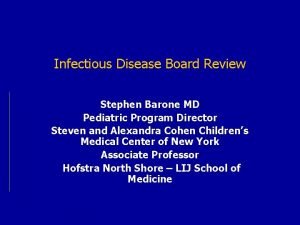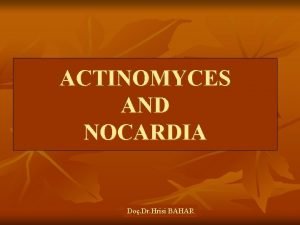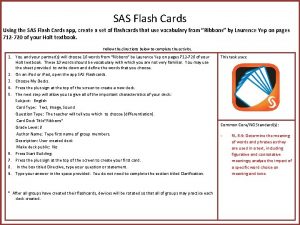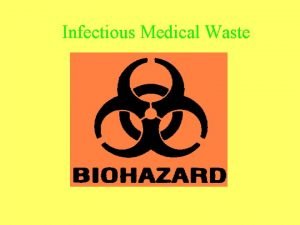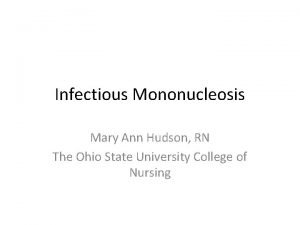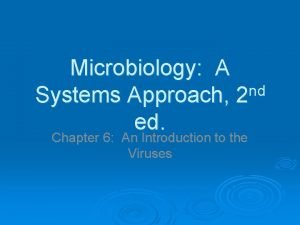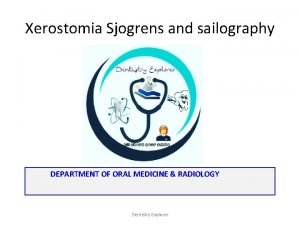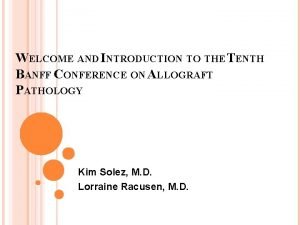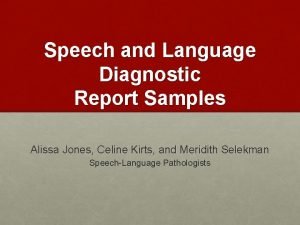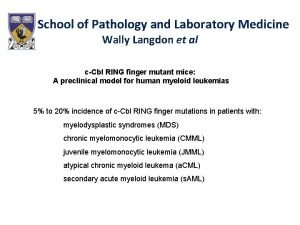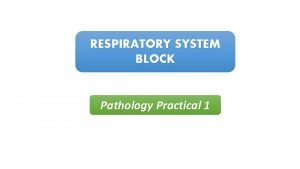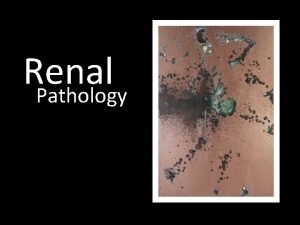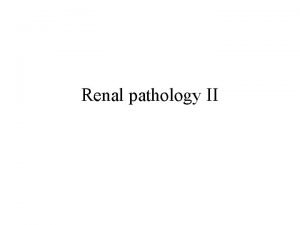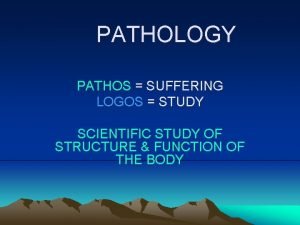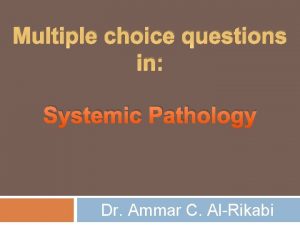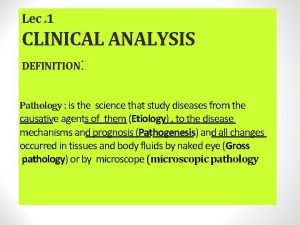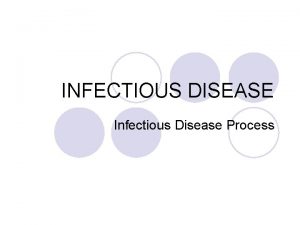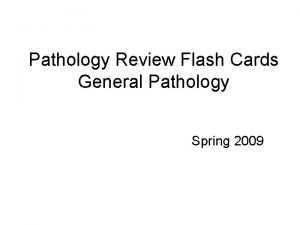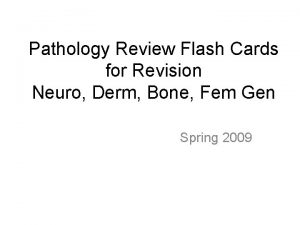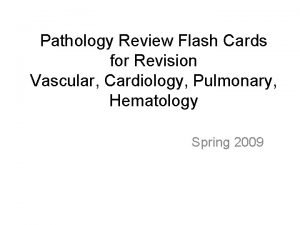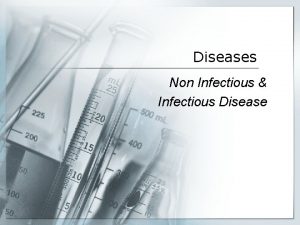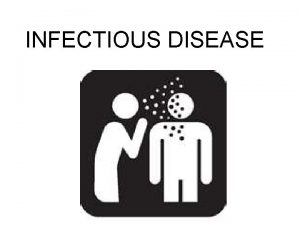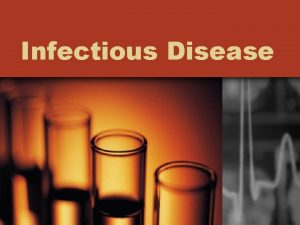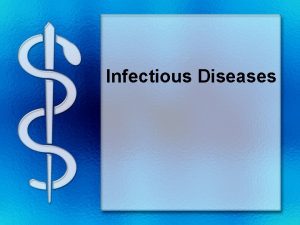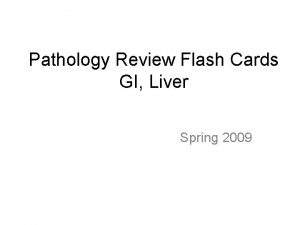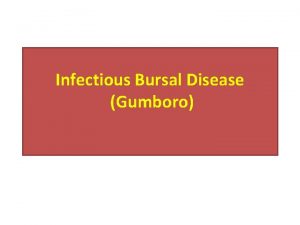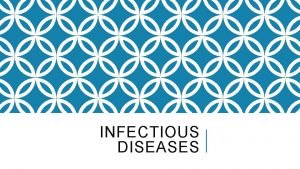Pathology Review Flash Cards for Revision Infectious Disease






















































































































- Slides: 118

Pathology Review Flash Cards for Revision Infectious Disease, Rheumatology Spring 2009

Staph and Strep - General • Gram+ cocci (staph = clusters; strep = chains) • Pyogenic abcess formation • Suppurative response due to neutrophils leads to liquefactive necrosis – Neutrophils also cause bystander tissue damage • Spread along tissue planes • Opsonization by C 3 b and phagocytosis important for control of infection, antibodies help neutralize toxins • Diseases with decreased neutrophil function (diabetes, chronic granulomatous) increased pyogenic infection

Staphylococci • Normal flora – common cause of skin abscesses, wound infections – Major cause of infection in burns, surgical wounds, nosocomial infections • Virulence factors for S. aureus, S. epidermidis, S. saprophyticus – All Catalase Pos; Only S. aureus is coagulase pos. – Protein A—binds Fc receptor; protects from opsonization – Coagulase—fibrin clot protects from phagocytosis – Penicillinase—inactivates penicillin – Hyaluronidase—spreading factor; destroys connective tissue – Exfoliatin—scalded skin syndrome – Enterotoxins—heat stable, food poisoning (milk, meat, mayo) – Toxic Shock Syndrome Toxin (TSST-1)—superantigen; binds MHC II and T-cell receptor polyclonal activation

Staphylococci • Types of Infection – Overgrowth of normal flora, access to sterile areas, ingestion, infection in immunosuppressed patients • Direct Organ Invasion: – Skin: impetigo (honey-colored crust), cellulitis, abscesses, wounds (leave open to heal by 2 nd intention if infected) – Pneumonia: 2 to viral infection or obstructive illnesses; abrupt onset of fever with lobar consolidation of lung and rapid destruction of parenchyma with pleura effusions and empyema. – Osteomyelitis: usually boys < 12 yo; hematogenous spread – Acute Endocarditis: Massive, rapid destruction of heart valves – Septic Arthritis: Most common cause in kids and adults >50 – S. saprophyticus: normal flora; urinary tract infections in women

Streptococci - General • Suppurative, spreading infections – Skin – cellulitis, impetigo, erysipelas, GABHS – Upper respiratory – strep throat • Post-strep hypersensitivity – Rheumatic fever (acute/chronic), immune complex glomerulonephritis, erythema nodosum (vasculitis) • Subtypes – Group A – GABHS (S. pyogenes), pharyngitis, post-strep rxns – Group B – perinatal sepsis, UTIs, pneumonia, meningitis – Group D – anaerobic (S. faecalis)/enterococcus – Viridans – α-hemolytic, subacute bacterial endocarditis – Strep pneumoniae – encapsulated, Ig. A protease causes meningitis, otitis media in children, pneumonia, and sinusitis

Streptococcus • Virulence Factors – Cell wall polysaccharides/M-protein– inhibits complement/phagocytosis – Enzymes: streptokinase (breaks up fibrin), streptolysin O, S (destroys RBCs and WBCs) – Erythrogenic toxin – characteristic fever, rash, pain • Types of infections – GABHS – acute pharyngitis (punctate abcesses) – Scarlet fever – prolonged Group A pharyngitis, red rash on trunk, strawberry tongue, desquamation of skin – Post-strep sequelae – glomerulonephritis (sx of acute renal failure), rheumatic fever – Skin – impetigo, pyoderma (superficial layers), erysipelas (middle-aged, warm climate, no suppuration)

N. meningitidis (Meningococcus) • Gram negative diplococcus • Complex nutritional requirements, especially iron • Colonizes mucosal surfaces in nasopharynx, can invade and cause purulent meningitis and bacteremia – Commonly causes cluster epidemics • Virulence factors: antiphagocytic capsule with LPS, secretion of Ig. A protease – Can lead to DIC, vascular collapse (most common cause of death) – Petechial rash indicates systemic dissemination – Ig. A protease facilitates survival on mucosal surfaces • Short incubation period (< 1 wk), can be fatal if not treated quickly

Haemophilus influenzae • Gram-negative pleomorphic bacteria • Upper respiratory, sinus, otitis, pneumonia, meningitis • Unencapsulated forms cause respiratory infections, colonize respiratory tract; capsulated forms cause invasive disease – Capsule type B (HIB) most common invasive form – Causes meningitis in young (1 -6 years), epiglottitis (can compromise airway) – Has endotoxin characteristics, can cause DIC • Window of susceptibility – 3 months to 6 years • Vaccine now available, has reduced incidence of HIB diseases in children – Capsular polysaccharides conjugated to protein to boost effectiveness in infants

Bordetella pertussis • Gram negative coccobacillus, causative agent of whooping cough • Colonization via filamentous hemagglutinin adhesin to carbohydrates on respiratory epithelium and CR 3 (Mac-1) on macrophages • Pertussis toxin (exotoxin) homologous to Cholera and E. coli heat-labile toxin, ADP ribosylates Gi protein allowing unregulated activity of adenylate cyclase to increase c. AMP, this paralyzes cilia and promotes lympocytosis by inhibiting chemokine recptors • Laryngotracheobronchitis that spares alveoli • Striking lymphocytosis (up to 90%) and enlarged peribronchial lymph nodes

Corynebacterium diphtheriae • Gram positive club, metachromatic granules, grows on tellurite agar • Phage-encoded A-B toxin ADP ribosylates elongation factor 2 (EF-2) inhibiting protein synthesis • Attachment to upper airway, release of exotoxin causes epithelial necrosis with fibrinosuppurative exudate that coagulates to form grey superficial membrane • Intense neutrophilic infiltrate, neovascularization, interstitial edema of tissue • Bacterial invasion remains local, lymphadenopathy + splenomegaly due to hemotagenous spread of exotoxin • Toxin also causes fatty myocardial change and necrosis, polyneuritis with myelin degeneration

Nosocomial Infections • E. coli and Staph Aureus are major players but Klebsiella and Pseudomonas are primarily nosocomial • Klebsiella Pneumonia (gram neg rod) – Aspiration Pneumonia in hospitalized patients, alcoholics, diabetics may cause Necrotizing Abscesses. – Urinary Tract Infections seen secondary to obstruction. – Septicemia and Meningitis due to its thick mucoid capsule (inhibits phagocytosis).

Nosocomial Infections • Pseudomonas (gram neg rod, oxidase +) – ubiquitous in hospital setting, esp in water sources > Respirators! – Causes nosocomial pneumonia, urinary tract infection, and wound infection, Vasculitis “Blue haze” -> thrombosis & hemorrhage – High rate of mortality in cystic fibrosis, burn, and neutropenic patients – Sepsis manifests as Ecythema Gangrenosum; DIC due to endotoxin – Virulence factors include leukocidin, phospholipase, and Exotoxin A

Food Poisoning/Enteritis • Common Causes: – Vibrio parahemolyticus-contaminated seafood – Bacillus cereus – reheated rice – Staph. aureus – meats, mayonnaise, custard – Clostridium perfringens – reheated meat dishes – C. botulinum – improperly canned foods – E. coli 0157: H 7 – undercooked meat – Salmonella – poultry, meat, and eggs – S. aureus and B. cereus have the fastest onset

Food Poisoning/Enteritis - Salmonella • General Characteristics – Gram negative rod, flagellate – non lactose fermenting, produces H 2 S • Transmission – urine/feces, turtles, undercooked chicken, eggs, meat • Pathogenesis - invades mucosal cells and cause mucosal ulceration – do NOT produce enterotoxins – multiply within neutrophils and macrophages • Forms – Enteric fever – fever, bacteremia, assoc. w/ sickle cell, schistosomiasis – Food poisoning – V/D, superficial lesions, worse in immunosuppressed

Food Poisoning/Enteritis - Shigella • General Characteristics – Gram negative non-lactose fermenting rod, does NOT produce H 2 S – Facultative anaerobe – nonmotile – spreads by actin tails • Pathogenesis – Spread by food, fingers, flies, feces – Escapes phagolysosome and destroys host cell – Shigatoxin - Necrotizing exotoxin causes mucosal necrosis fibrinosuppurative exudate – Spreads to lymph nodes, but NO bacteremia – Highly virulent - <200 bacteria cause infection • Classical dysentery - bloody diarrhea with inflammatory cells

Food Poisoning/Enteritis • Yersinia entercolitica – Motile gram negative rods with bipolar staining – Transmitted from pet feces, contaminated milk, or pork – Outbreaks common in day care centers – MIMICS APPENDICITIS and CROHN’S • Pathogenesis – Ulcerative mucosal lesions with invasion of lymphoid tissue, hemorrhagic dysentery; Necrotizing granulomas of Peyer’s patches

Food Poisoning/Enteritis • E. coli – Gram negative rods – EMB or Mc. Conkey Agar – Lactose fermenting (coliform) – Some strains have flagella – Causes: • K 1 type causes neonatal meningitis • Gastroenteriris, HUS, UTI, pneumonia.

Food Poisoning/Enteritis • E. coli types – Enterotoxic (ETEC)- enterotoxin-producing strain. Causes watery diarrhea: LT tox (c. AMP), ST tox (c. GMP) – Enterohemorrhagic (EHEC) severe bloody colitis virotoxinproducing strain (mainly O 157: H 7). HUS. Found in Raw meat! – Enteropathogenic (EPEC) – effacement of microvilli – Enteroinvasive (EIEC) – invades mucosa. acts like shigella – Enteroaggregative (EAEC)- primarily pediatric diarrhea in impoverished nations

Food Poisoning/Enteritis • Vibrio cholerae – Gram negative “comma shaped” rod – Same disease as ETEC but more severe • Pathogenesis – Enterotoxin that ADP ribosylates a stimulatory G – Protein causing secretory diarrhea • Clinical – Copius diarrhea – up to 20 L / day – Rice water stools – Shock from isotonic fluid loss if not rehydrated

HUS, E. coli O 157: H 7 • Shiga-like toxin of O 157 H 7 (uncooked beef) – Endothelial damage at arteriole-capillary junction – Glomerular thrombotic microangiopathy: platelet-fibrin micro thrombi – Splitting of glomerular capillaries due to subendothelial swelling – Interlobular arteries: fibrinoid necrosis, subintimal fibrin deposits – Patchy or diffuse renal cortical necrosis • Primarily in children (25% go to Renal failure) – Immediate: nausea, abdominal cramping, fever – 3 d: dark urine, hematuria, dark stools – DIC: elevated D-dimer, schistocytes, thrombi • Adult: TTP

Salmonella Typhi • Salmonella Typhi – G- bacillus; humans are only known host – fecal-oral transmission; 1 -2 wk. incubation – facultative intracellular parasite – disseminates, causes typhoid fever – asymptomatic carrier state possible (gallbladder) – Invasive, “rose spots” on chest + abdomen – hepatosplenomegaly, invasive mucosal lesions w/lymphoid tissue tropism – widespread mononuclear phagocytic involvement (wk 2) – typhoid nodules throughout immune tissue (includes liver), Peyer’s patches enlarge and later ulcerate

Clostridial Diseases • Clostridium perfringens, Clostridium septicum – Cellulitis and gas gangrene, uterine myonecrosis (illegal abortions), food poisoning, tissue death allows growth (anaerobes) – Cellulitis: foul odor, thin discolored exudate, rapid and large tissue destruction, granulation tissue at borders, tissue necrosis disproportionate to nutrophil presence – Gas Gangrene: marked edema and enzymatic necrosis of muscle cells, extensive fluid exudate, large bulla that rupture, inflamed muscles soft, blueblack, friable, and semifluid, myonecrosis and hemolysis

Clostridial Diseases • Clostridium tetani – Proliferates in punture wounds/umbilical stump of newborns, convulsive contractions of skeletal muscles • Clostridium botulinum – Proliferates in non-sterile canned foods, elaborates neurotoxin blocking ACh release, severe paralysis of respiratory and skeletal muscles • Clostridium difficile – Pseudomembranous colitis, often nosocomial, seen in debilitated patients and those on long term broad spectrum antibiotics

Rickettsia • Intracellular infection of endothelial cells with perivascular lymphocytic infiltrate (“perivascular cuffing”) • obligate intracellular bacteria that can be found in ticks, mites, fleas, or lice, aquirred by accidental exposure usually • Eschar- dark, swollen, crusted lesion at inoculation site • rash, small vessel vasculitis • microthrombi, focal ischemia, or hemorrhage; also hypovolemic shock with peripheral edema possible • lyse endothelial cell (typhus group) or spread cell to cell (spotted fever group) • no exotoxins and no endotoxins; • Diagnosis: immunostaining of organisms or antirickettsial serology

Rickettsia • Epidemic. Typhus (R. prowazekii)- head lice (prisons, concentration camps, refugee camps) – centrifugal rash followed by CNS involvement - apathy, dullness, stupor, and coma – high fever, chills, cough, rash, severe muscle pain, sensitivity to light, delirium • Spotted Fever Group – Rocky Mountain Spotted Fever- R. rickettsi; tick bite (ixotid or hard ticks – American Dog Tick, Rocky Mountain Wood Tick) – fever, nausea, vomiting, headache, muscle pain, anorexia – hemorrhagic rash extends over entire body, including palms and soles; rare eschar- rash does not occur in all individuals – Cause of death- pulmonary edema (untreated- 30% mortality)

Rickettsia/ Ehrlichiosis • Ehrlichiosis (E. chaffeensis or Anaplasma phagocytophilum)- tick vector in US – Similar symptoms to Rocky Mountain Spotted Fever, but rash rare, less prominent; no eschar – infects neutrophils or monocytes – characteristic cytoplasmic inclusions (morulae) – masses of bacteria shaped like mulberries • Scrub typhus (Spotted Fever Group) – – endemic in Far East, China, Indi transmitted by chiggers rash transitory or absent may be a prominent lymphadenopathy

Lyme Disease • Clinical Associations – Borrelia burgdorferi, rodents to humans via Ixodes deer ticks, Northeastern US, Lyme CT, “The Great Imitator. ” • Stage 1 (gone in 4 -12 wks) – spirochetes spread in dermis, bulls eye rash (erythema chronicum migrans) characterized by edema and lymphocytic plasma cell infiltrate, fever, lymphadenopathy. • Stage 2 (early disseminated stage) – organisms spread hematogenously, secondary skin lesions, meningitis with cranial nerve involvement (CSF is hypercellular with lymphocytes and anti-spirochete Ig. G), lymphadenopathy, migratory muscle and joint pain. – Early lyme arthritis resembles early RA with villous atrophy, lining cell hyperplasia, and lymphocytes and plasma cells in the sub-synovium.

Lyme Disease • Stage 3 (2 -3 yrs after bite) – chronic arthritis (extensive erosion of cartilage), encephalitis, carditis. • Immune Response – Initially, bacterial lipoproteins stimulate TLR-2 on macrophages to release IL-1, IL-6, TNF. – Adaptive immune response – CD 4+ T-helpers and B cells. – Antibodies made 2 -4 wks after bite, but Borrelia escapes antibody response via antigenic variation.

Pet-Associated Diseases Pasturella multocida (Gram-negative coccobacillus) animal bites, scratches (cat) Rapidly developing cellulitis, abscesses sepsis Bartonella Cat Scratches Henselae—Cat Scratch Disease (Gram-negative rod) Self-limited—papule develops 3 -10 days & fever and lymphadenopathy develop 2 weeks after contact, Immunocompromised: Bacillary angiomatosis-proliferation of small blood vessels Leptospirosis (Leptospira Interrogans) Self-limited, febrile illness with biphasic fever and meningeal irritation; conjunctival irritation and hyperemia; lymphocytic atypical meningitis; jaundice, bleeding, and renal failure (Weil’s disease)—spreads in liver, spleen, kidneys, and CNS with little cellular reaction Common in dogs; organism secreted in urine —campers and swimmers

Pet-Associated Diseases Toxoplasmosis Shed in feces of —Toxoplasma cats gondii (obligate intracellular protozoan) Chlamydia Psittaci-Ornithosis Normally subclinical or mild lymphadenopathy, serological titers confirm previous infection and protective immunity; Encephalitis in immunocompromised; TORCH in infants, TRANSPLACENTAL— chorioretinitis and blindness in 3 rd trimester, 25% fatality in 1 st Trimester Inhalation of dust- Enters through respiratory tract and borne excretia causes patchy inflammation of the lungs; from birds interstitial edema, hyperemia, and mononuclear infiltrate Rabies—Rabies Saliva of infected Virus animal (dog, raccoon, bat) CNS-hydrophobia; lesions characterized by presence of Negri bodies in nerve cells; only diagnosed by direct exam, treat with vaccine and Ig; vaccine for high -risk

B. anthracis (Anthrax) • Gram-positive, encapsulated, spore-producing rod • Transmitted through contact with animal products (sheep, goats) • 2 disease forms: – Cutaneous disease – eschar formation, painful lympadenitis – Pulmonary disease – pneumonia with serofibrinous exudation, septicemia, possible DIC (woolsorter’s disease) • Virulence factors: antiphagocytic activity (capsule), edema factor, cytotoxic factor; causes leukopenia • Stable in environment, highly virulent -> bioterrorism • Treatment: penicillin, doxycycline, vaccination available

L. monocytogenes (Listeriosis) • Small gram-positive rod; motile; facultative psychrophile (likes cold) • Transmitted by contact with infected animals, uncooked food, unpasteurized milk – Also, maternal-fetal transmission • Causes: – Spontaneous abortion – Neonatal sepsis with meningitis – Meningitis in adults if immunosuppressed • Exudative meningitis in adults -> can see gram positive rods in CSF • Need intact cell-mediated immunity to fight infection

Mycoplasma • Cell membrane contains sterols; no cell wall • Pneumonia (walking/atypical) – M. pneumoniae – Xray looks worse than patient presents, high Ig. M titer. – MC pneumonia in school children/young adults, military. • may have hemorrhagic bullous myringitis • cold agglutinin immune hemolytic anemia • diffuse, patchy inflammation in interstitial areas of alveolar walls, intraalveolar hyaline membrane • Urethritis – NGU; Ureaplasma urealyticum, M. hominis

Mycobacteria • Acid fast, mycolic acid in cell walls, intracellular • Glycolipids prevent phagolysosomal membrane fusion • M. tuberculosis - *caseating granulomas* – Histiocytes (epithelioid cells), Langhans giant cells, peripheral collar of fibroblasts and lymphocytes • Granuloma formation – macrophages unable to kill bacteria persistent infection recruits TH 1 cells secrete IFNγ activate epithelioid macrophages • PPD/Tuberculin test – test for infection; Type 4 hypersensitivity reaction

M. Tuberculosis • Primary – localized; Ghon focus (TB granuloma) in periphery of lower upper lobes or upper lower lobes with hilar/lobar lymph nodes (Ghon complex) • Secondary – cavitary lesions in apical lobes (↑ O 2 tension); may rupture into bronchi; fever, night sweats, weakness, anorexia, weight loss, productive cough, blood in sputum • Tertiary – extension in lung and to opposite lung; bacteremia miliary TB may spread to cervical nodes, meninges, kidneys, adrenal glands, bones (Pott’s disease in spinal cord), uterus, small intestine

Other Mycobacteria • M. kansasii or MAC – pulm. disease; associated w/AIDS, chronic bronchitis and emphysema • M. bovis – unpasteurized milk, some pulmonary infections • MAC & M. scrofulaceum (kids) cervical lymphadenitis • M. leprae Leprosy (Hansen’s disease); cool areas – skin – macules/papules/nodules – nerves (ulnar & peroneal) – paresthesias/anesthesias • tuberculoid – high immunity, form granulomas, self-limited; • lepromatous – low T-cell immunity, organisms proliferate in macrophages; contagious and lethal

Infectious STDs - Chlamydia • Clinical Features: – reactive arthritis (Reiter’s), conjunctivitis, nongonococcal urethritis, PID. – #1 STD in U. S. ½ asymptomatic. – #1 worldwide cause of preventable blindness (Trachoma; casual spread). Congenital inf. causes inclusion conjunctivitis (benign, self-limited), trachoma, & infant pneumonia. • Micro: G-; Obligate intracellular organism of mucosal epithelium; lacks muramic acid and peptidoglycan wall.

Infectious STDs - Chlamydia • Path: Two forms: – Elementary body (infectious, enters by endocytosis) – Reticulate body (replicative form). Enhances HIV transmission. • Diagnosis: cytoplasmic inclusion bodies on Giemsa stain or fluorescent antibody stained smear; Urine DNA amplification tests. • Treatment: erythromycin or tetracycline.

Infectious STDs - Neisseria • 1) Neisseria gonorrhoeae—Gonorrhea – Clinical Features: • Urethritis, cervicitis, PID, prostatitis, epididymitis, septic arthritis, creamy purulent discharge. • 2 nd most common STD. #1 cause of septic arthritis in young, sexually active people. – Micro: Pyogenic, encapsulated, G- diplococcus. • 2. ) C. donvani— Granuloma Inguinale, – chronic STD with ulcerating and granulating lesions of genital skin and mucosa

Infectious STDs - Neisseria • Path: – Antigenic variations allow evasion and re-infection; – Adhesins and pili allow it to bind to epithelium; – Ig. A protease stops Abs; Capsule inhibits phagocytosis. . • Diagnosis: Gram stain and see diplococci within the WBCs. • Tx: Ceftriaxone; add doxycycline or azithromycin for Chlamydia

Infectious STDs • Trichomonas vaginalis— Trichomoniasis, – Clinical Features: Women: vaginitis, copious secretions, strawberry mucosa. Men: asympt. or nongonococcal urethritis – Micro: flagellated protozoan which occupies the vagina & urethra. – Path: mild tissue rxn 2 bact. infection purulent urethritis & mucosal papules (strawberry muc. ). Trophozoite growth results in profuse, watery, leukorrheic disharge with vulvovaginitis. – Dx: Motile, turnip-shaped trichomonads on fresh prep of discharge. • Condylomata acuminata —genital warts, koilocytes, HPV 6/11. • Haemophilus ducreyi —Chrancroid – (painful, soft genital ulcer) at site of inoculation, inguinal adenopathy. Ulcer facilitates HIV transmission. Underdeveloped Countries.

Infectious STDs - Syphilis • Treponema pallidum—Syphilis • Micro – G- spirochete – Produces no toxins • Path – 1 : local reacion • no toxins damage from immune rxn. • Mononuclear infiltrate with plasma cells, obliterative endarteritis & vessel wall infiltrates – 2 : Bacteremia systemic manifestations • (maculopapular rash including palms and soles)

Infectious STDs - Syphilis • Path cont’d – 3 : Cardio most affected • Aortitis (vasa vasorum destroyed obliterative endarteritis (treebarking) damage prox aorta & root aneurysms & dissections) • Gummas (liver, bones, testes, skin) from DTH (Type IV) rxn w/central necrotic debris bordered by palisading mphages and fblasts. No treponemes. • Neurosyphilis: Tabes dorsalis (post. column sensory loss charcot joints); general paresis, Argyll Robertson Pupils (midbrain lesions; pupil constricts with accommodation but not with light)

Infectious STDs - Syphilis • Clinical Features: – Primary: Painless, hard chancre that appears 3 -6 weeks after inoculation & lasts one month. VDRL and Anti-treponemal antibodies are neg. but organisms can be extracted from lesions – Secondary: ~6 weeks after 1 lesion heals; fever, condyloma lata (elevated broad plaques) on penis/vulva, lymphadenopathy, skin rashes (esp. palms and soles), VDRL and Anti-trep antibodies are positive, organisms can be extracted from lesions. – Tertiary: After asymptomatic latent period (>5 years). Gummas; Neurosyphilis; Argyll Robertson pupils (pathognomonic for 3 ); Tabes dorsalis; aortic aneurysm and dissection; general paresis. VDRL and Anti-trep abs are pos but organisms can’t be found.

Infectious STDs • Congenital Syphilis (TORCH)—Treponemes cross BBB. Periosteal inflammation Saber shins (bowing), saddle nose, eighth nerve deafness*, Hutchinson’s teeth*, and interstitial keratitis*. *Hutchinson’s Triad • Herpes Simplex Type 2: Genital Herpes • Clinical: painful penile, vulvar, or cervical ulcers; Congenital (TORCH) syndrome generalized lymphadenopathy, splenomegaly, corneal lesions, CNS damage (deafness, ataxia) • Micro: Encapsulated virus with ds-DNA. • Path: Cell destruction separation of epithelium vesicles. Viral assembly forms intranuclear inclusions. Viral proteins fuse cells forming multinucleated giant cells. Scrapings reveal intranuclear inclusion-bodies within multinucleated giant cells (TZANCK PREP).

Measles/Rubella • Measles paramyxovirus – – Highly contagious- epidemics Cough, coryza conjunctivitis Macular papular rash that coalesces Koplik spots red spot w/bluish-white center near Stensen’s duct – Warthrin-Finkeldy multinucleated giant cell- pathognomonic!! – Subacute sclerosing panencephalitis (Dawson encephalitis) is a potential sequela • Rubella togavirus – Infections of children mild but part of congenital TORCH syndrome – Transmission through placenta – Congenital heart and major vessel defects, ocular lesions, deafness, microcephaly, mental retardation, growth retardation

Mumps • Mumps paramyxovirus – Dz of parotid gland – Can affect pancreas, ovaries, testes hemorrhage into testis can cause permanent damage and sterility- usually unilateral – Intense interstitial edema and monocytic infiltrate • Vaccination MMR for all three at >12 months and again at 4 -6 years of age

Herpes – HHV 6 and 8, Herpes Fun Facts • HHV 6 – Roseola; begins as a high fever; when the fever disappears, a red rash develops; mono-like in adults. • HHV 8 – Kaposi’s sarcoma; cancer of lymphatic endothelium forming blood-filled channels; associated with AIDS as an opportunistic infection; lesions occur on the skin, mouth, GI tract, and respiratory system. Patches are pink to red to purple. Initially difficult to discern from granulation tissue. Later lesions become raised plaques with dilated jagged vascular channels. • All herpesviruses are DS linear DNA • All have the characteristic multinucleate giant cells and intranuclear Cowdry type A inclusion bodies.

Herpes • HSV 1: gingivostomatitis (cold sores); HSV 2: genital lesions; characteristic multinucleated giant cells with intranuclear inclusions – TZANK prep. • Virus enters skin; infects and becomes latent in nerves. • Can also cause keratitis, encephalitis, and disseminated disease (immunocompromised); keratitis can lead to corneal blindness. • One of the TORCH diseases – lymphadenopathy, splenomegaly, necrosis, corneal lesions, CNS damage.

Varicella-Zoster • Transmitted by aerosols then viremia leads to rash beginning on face and spreading to rest of body, including mucous membranes • Vesicles resemble “dew drop on rose petal”, and occur in crops; itch when healing. • Latent in neurons of the DRG. • Shingles occurs from reactivation of VZV and is distributed along a sensory dermatome; painful, vesicular rash; rare interstitial pneumonia, encephalitis, or necrotizing lesions.

Cytomegalovirus • Cytoplasmic “owl’s eye” inclusions; spread by resp. drop. • Most people get an asymptomatic infection. • Other possible infections – CMV mononucleosis; reactivation in AIDS (CMV retinitis); reactivation in bone marrow transplant (CMV pneumonitis); in AIDS patients accompanied by PCP. • Congenital infection (TORCH) – hemolytic anemia, jaundice, thrombocytopenia purpura, hepatosplenomegaly, deafness, chorioretinitis, brain damage, encephalitis.

EBV • Mononucleosis – self limited; pharyngitis, fever, chills, sweats, headaches, swollen lymph nodes, and hepatosplenomegaly with risk of splenic rupture • Spread thru saliva; causes polyclonal activation of Bcells (attaches to CD 21) • Atypical lymphocytes are T cells; absolute lymphocytosis • Heterophile antibodies useful – MONOSPOT TEST (detect Ig against Horse RBCs) • Associated with Burkitt’s Lymphoma and nasopharyngeal carcinoma.

Lower Respiratory Tract Infections • Influenza, Parainfluenza, Respiratory Syncytial Virus – Spread by aerosolized droplets • Influenza – – orthomyxovirus with single strand negative (SS-) RNA hemagglutinin promotes viral entry neuraminidase promotes release of viral particles Antibodies to hemagglutinin and neuraminidase are protective but antigenic shift and drift result in subsequent infections – Virus grouped into types A, B, C (type A responsible for pandemics and epidemics) • Pathology: Interstitial Pneumonia – Mucosal hyperemia with lymphomonocytic and plasmacytic infiltration of submucosa – Mucosal hypersecretion -> can lead to Secondary Bacterial Infections (usually Staph Aureus). Major cause of mortality

Lower Respiratory Tract Infections Cont’d • Parainfluenza Paramyxovirus, single strand negative SS- RNA – Mostly infects children, causing Croup (laryngotracheobronchitis) in young children • Croup is a harsh barking cough usually accompanied by inspiratory stridor • Inspiratory stridor is due to airway obstruction from submucosal edema in the trachea • Respiratory Syncytial Virus Paramyxovirus, SS- RNA – Most common cause of viral pneumonia and bronchiolitis in young children and common cause of death in infants 1 -6 mos. – Healthy adults are protected by Ig. A in the airways – Fusion proteins from the virus cause formation of multinucleate giant cells in respiratory tissue.

Rotavirus • encapsulated, ds. RNA virus • COMMON cause of gastroenteritis in children aged 624 months; causes vomiting and watery diarrhea • selective infection & destruction of mature enterocytes in small intestine, sparing crypt cell • ↓ absorption of nutrients → osmotic diarrhea and dehydration • outbreaks in day-care centers, hospitals • highly infectious: minimum infectious dose just 10 particles • immunity transferred through antibodies in maternal milk, so infection common at weening

Norwalk • ss. RNA virus • causes gastroenteritis with watery diarrhea, nausea, vomiting, abdominal pain • transferred via food, water, person-person; extremely sturdy virus, difficult to kill • occur in epidemics, common on cruise ships • 1 -2 day incubation, symptoms lasting 12 -60 hours

Polio & Coxsackievirus (Enteroviruses) • Enteroviruses small, +sense single stranded RNA • Transmitted by fecal/oral route, respiratory secretions • Can be asymptomatic, or cause mild respiratory infection, rash, aseptic menigitis, some assoc w/ severe complications • may be related to onset of type I diabetes • Coxsackie A – Hand Foot & Mouth Disease and Herpangina – Hand foot & mouth – fever/malaise, then 2 days later painful oral vesicles and maculopapular rash on hands & feet – Herpangina – fever, sore throat, red-based vesicles on back of throat • Coxsackie B – Myocarditis, Pericarditis – Myocarditis – lymphocytic infiltrate & associated myocyte injury

Polio & Coxsackievirus (Enteroviruses) • Poliovirus – Initial replication occurs in peyers patches & tonsils • Asymptomatic, or causes a mild febrile viral illness in most people, can also cause aseptic meningitis w/ complete recovery – In 1% of cases, spreads to blood and then across the blood. CNS barrier to motor neurons in the anterior horn of spinal cord causes paralysis (pain, weakness, LMN signs) – Vaccinations • Salk – inactive virus injection, no risk of vaccine-associated disease • Sabine – oral attenuated virus, longer duration of immunity and “free immunization” of others by virus shed in stool, but carries risk of vaccine associated polymyelitis in immunocompromised

Parvovirus • Parvovirus B 19 (small, single stranded DNA virus) – Respiratory transmission, children age 4 -12, 20% asymptomatic – Fifth disease (Erythema Infectiosum) – Fever & “slapped-cheek” rash; lacy red rash on trunk & limbs that may itch, no longer contagious by the time the rash occurs – associated with aplastic anemia in patients with sickle cell, chronic diseases, or immunosuppression • Virus interferes with RBC production in the bone marrow • Pink intranuclear inclusions present in RBC precursors – Pregnant mothers can pass the virus to the fetus, resulting in severe anemia with fetal hydrops

Adeno, Rhino, & Coronavirus • Infection confined to upper respiratory tract – “common cold” – Virus prefers cooler temperatures • Rhinovirus – single stranded +sense RNA, >100 serotypes – Cause >50% of common cold – Virus binds to ICAM-1 infects humans and higher primates that have ICAM-1 on their epithelial cells – hypersecretion due to bradykinins and inflammatory response • Coronavirus – single stranded +sense RNA – 2 nd most common cause of common cold, profuse nasal discharge • Adenovirus – double stranded DNA – rhinitis, pharyngitis, fever, conjunctivitis, keratoconjunctivitis (“pink eye”) – Can progress to lower respiratory tract pneumonia in children – Smudge cells and Cowdry type A intranuclear inclusion bodies

West Nile, Dengue • RNA (Single-stranded + linear)-Flavivirdae viruses • Spread by Mosquito vector, infecting humans and birds • Dengue Fever • Primarily in tropics, some in SW U. S. • “Break-bone fever”- b/c of backache, joint pain, and severe headache. PAINFUL FEVER! • Serotype 2 Dengue Hemorrhagic fever – Causes hemorrhage or shock, especially in children • West Nile Virus – Birds are major reservoir, humans are accidental hosts – Broad geopraphical distribution – Sx: -Most are asymptomatic, some develop headache , fever, and maculopapular rash; – Meningitis/encephalitis/meningoencephalitis in 1: 50 of clinically infected individuals – Immunosuppressed and the elderly at greatest risk

Smallpox, yellow fever • Smallpox – Family of poxviridae (Variola major and minor) – Only infects humans-NO animal reservoirs – HIGHLY contagious, spread person to person – No known treatment w/ mortality of 30% – Clinical presentation • Deep Lesions, which develop at the same time (Synchronous) • Centrifugal spread (mostly face and palms); fever • Yellow fever – RNA Flavivirus (yellow fever virus), arbovirus – Transmitted by the Aedes mosquitos. Monkey or human reservoir – Clinical Presentation • Hepatitis and jaundice (may see Councilman bodies in liver) • Fever, backache, nausea, and vomiting

Ebola and Hanta (Hemorrhagic Fevers) • Ebola – negative sense ss. RNA, Filovirus; no vector definitively identified, monkeys? – Person to person; nosocomial in endemic areas; isolation is essential – Hemorrhagic manifestations from many organ systems, hepatic especially; visceral organ necrosis – Die secondary to hemorrhage, massive fluid loss, shock and DIC. • Hanta – negative sense, ss. RNA, Bunyavirus, very rare in US – Inhaled rodent urine and feces, Southwest US – Acute hemorrhagic pulmonary syndrome, mortality 50% – Fever, hemorrhage, ARDS, DIC

Actinomyces and Nocardia • Nocardia and Actinomyces are bacteria that act like fungi • Exhibit branching and Mycelial Network • Nocardia infects the immunosupressed – 1) Pulmonary with single or multiple necrotizing abcesses. – 2) Disseminated: Meningitis – 3) Skin Lesions

Nocardia & Actinomyces Cont. • Actinomyces (strictly anaerobic, lives in devitalized tissue) – Chronic suppurative infection. SULFUR GRANULES in exudate. – Three disease forms: Cervicofacial, Abdominal, thoracic • Cervicofacial = most common form. Begins in Gingiva. Invasive Lesions which perforate and form abscesses. – Central suppurative necrosis surrounded by granulation tissue and fibrosis • Abdominal = Invasions of the Intestinal mucosa • Thoracic = Lung abscesses, empyema

Mucormycosis & Aspergillus • Murcormycosis: Irregular nonseptate hyphae w/ wide angle branching – Pathogenesis: Invasion of arterial wall w/hemorrhage and thrombosis • 3 primary sites: – Rhinocerebral (Diabetic ketoacidosis): local tissue necrosis. Invasion into Cranium *Meningoencephalitis – Lung: Hemorrhagic pneumonia – GI involvement with severely malnutrition in children *Occurs in immunosupressed, diabetic ketoacidosis *Often Nosocomial

Aspergillus • Septate hyphae with narrow angle branching: Fruiting Bodies – Pathology: Same as mucormycosis. Also has aflatoxin (carcinogen/Liver cancer) • Allergic: Alveolitis (III, IV), asthma (I) • Colonizing: Fungus Balls in pre-existing cavities (minimal invasion) – Associated w/ recurrent hemoptysis • Invasive: necrotizing pneumonia, sepsis (esp. heart valves, brain, kidney) – Immunosupressed and debilated hosts

Candida • Morphology – pseudohyphae and budding yeasts • Path – Phenotypic switching – Adhesion protiens (yeast bind manose, hypahe bind Fc) – Enzymes and adenosine (blocks oxegyn radical formation) – Stimulates TH 1 response • Presents – Thrush, esophagitis, vaginaitis, coetaneous, invasive, endocarditis, – Normal flora – Superficial infx in healthy, disseminated in imunocomp. • Newborns, AIDS, Diabetics

Cryptococcus and Pneumocystis • Cryptococcus neoformans – Path: encapsulated yeast with 3 virulence factors • Polysaccharide capsule, melanin production, enzymes • Capsular polysaccharide stains red, Agglutinates latex – Found in soil and pigeon droppings – Primary infx in lungs, major lesion in CNS • Soap bubble lesions in meninges, gray mater, basal nuc. • Pneumocystis Jiroveci (PCP) – Path: yeast, cyst-forming lesions. Wide-spread pulmonary infiltrates on CXR – Affects immunocomped (AISDS) – Toluidine blue stain after lung lavage shows organism – TMP/SMX treatment and prophylaxis.

Histoplasmosis • Thermally dimorphic fungus in bat and bird droppings – Endemic to Ohio and Mississippi river valleys and Carribean; Microconidia are the infectious form • Yeast enters macrophages by induced phagocytosis – Proliferates in phagolysosome and lyses host cell – T-cells recognize antigens and induce granulomatous response • Presentation depends on host immune response – Immunocompetent host: epithelioid caseating granulomas; organization and concentric calcification; asymptomatic, but coin lesion on CXR – Chronic infection: clinically similar to TB with less cavitation – Fulminant disseminated: only in immunocompromised; granulomas absent; focal accumulations of yeast-filled Mø’s – Methenamine silver staining of yeast in affected tissue

Blastomycosis • Thermally dimorphic soil inhabitant in central/southeast US – Infective conidia transform into round, thick-walled yeast exhibiting broad-based budding • Macrophages have limited ability to phagocytose – Persistence of yeast leads to continued neutrophil recruitment • Abrupt illness with tuberculosis-like symptoms – Nodular or miliary infiltrates with lobar consolidation on CXR – Suppurative granulomas, most frequently in upper lobes – Can disseminate to skin, causing raised, ulcerating verrucous lesions with epithelial hyperplasia; can be confused with squamous cell carcinoma – Widespread dissemination in immunosuppressed

Coccidioidomycosis • Thermally dimorphic soil inhabitant of southwest US – Arthroconidia infect almost everyone; clinical illness in 10% – High infectivity requires careful handling by lab workers • Inhibition of fusion of phagosome and lysosome; T-cell stimulation results in granulomatous inflammation – Thick-walled, non-budding spherules within macrophages and giant cells – Rupture releases non-infectious endospores, stimulating a superimposed pyogenic inflammation – San Joaquin Valley Fever: fever, cough, pleuritic pain, erythema nodosum or erythema multiforme – Rare dissemination to meninges or skin; pyogenic inflammation may dominate, especially in immunosuppressed

• Babesiosis Protozoa – Similar to malaria, but found in the US – Protozoan transmitted by deer ticks (also carry Lyme disease) – Sx: Fever, hemolytic anemia, worse in debilitated and splenectomized • Trichomoniasis – Trophozoites—turnip-shaped motile organisms – Colonize vagina and male urethra – vaginitis, cervicits, urethritis – No tissue invasion with little inflammatory rxn, green frothy discharge – “Strawberry mucosa”, mixed cell infiltrate

Protozoa • African Sleeping Sickness (Trypanosomiasis) – Vector: Tsetse fly; Clinical: intermittent fevers, lymphadenopathy, splenomegaly, leptomeningitis, cachexia, death – Organism growth actually stimulated by IFNgamma; tissue destruction from antigen/antibody complex deposition – Red, rubbery chancre at site of infection; ulcer & mononuclear infiltrate

Protozoa • Chaga’s Disease (T. Cruzi) – vector: kissing bug; most common cause of heart failure in Brazil – chagoma at site of infection; infects macrophages; penetrates smooth, skeletal, and cardiac muscle – Acute: intracellular pseudocysts, fever, dilated cardiomyopathy, arrhythmias – Chronic: cardiac damage due to Antibody-T cell cross reaction

GI Protozoa • Amebiasis (Entamoeba histolytica) – Infections cysts lyse colonic epithelium of cecum and ascending bowel flask-shaped ulcers – Trophozoites invade the crypts of colonic glands, 40% penetrate portal vessels liver abscess – Clinical: dysentery ( in only 10%) • Giardia (Giardia lamblia) – Transmission via cysts in contaminated water and fecal-oral; Not killed by chlorine trophozoites resemble “cartoon ghost” – Clinical: diarrhea, steatorrhea, constipation, Ig. A Deficiency and the immunosupressed are more susceptible (but not worse clinical disease) – Clubbing of villi, but no invasion of intestinal wall;

GI Protozoa • Cryptosporidosis (Cryptosporidium parvum) – Oocytes: infectious, not killed by chlorine – Sporocytes: attach to brush border of apical epithelium – Clinical: malabsorption, secretory diarrhea, vomiting (3 -14 days); increased severity in immunosupressed – Organisms infect Peyer’s patches and macrophages, CD-4+ immunity needed to control parasites • Balantidiasis – Cysts are infectious through contaminated food and water, common in tropics, pigs – Clinical: Persistent diarrhea, dysentery, weight loss

Tissue Invaders • Toxoplasmosis: Obligate intracellular protozoan, cat is definitive host; Opportunistic AIDS infection; Oocytes shed in cat feces, infectious after 24 -48 hours, (scoop litter ASAP) – Fetus: chorioretinitis, damaging to heart, brain, lung development – Adults: follicular hypertrophy and lymphadenopathy • Leishmaniasis: sandfly vector; visceral form via RES – Kala-azar; cutaneous form with ulcer and granulomatous reaction; mucocutaneous form – disfiguring lesion; diffuse cutaneous form • Naegleria: water transmission; meningitis w/ death in kids (entry through cribiform plate), mimics meningococcus • Acanthamoeba: meningitis in immunocompromised via hematogenous spread, sense of smell/taste altered

Trematodes • Schistomosiasis – The life cycle involves fresh water snails, humans are affected when cercaria penetrate skin. Organisms migrate to portal vein and pelvic venous plexus. Immune response is granulomatous and eosinophilic with significant fibrosis (out of proportion to parasitic injury) – S. mansoni/japonicum pipestem fibrosis portal HTN – S. haematobium hematuria and bladder obstruction squamous cell carcinoma • Liver flukes (clonorchiasis) – from poorly cooked fish. – In biliary tracts portal fibrosis cholangiocarcinoma

Malaria Life Cycle • Sporozoites found in salivary glands of female Anopheles mosquito • Sporozoites enter the blood when bitten and invade liver cells (thrombospondin, properdin) where they multiple rapidly forming many merozoites (asexual, haploid) • Merozoites bind by a lectin like molecule to sialic residues on glycophorin on RBCs • The parasites grow within the RBC, hydrolyzing hemoglobin—trophozoite is the first stage in the RBC and is defined by a single chromatin mass – Detoxification of heme by forming paracrystalline precipitate (hemozoin) Chloroquine inhibits this detoxification

Malaria cont’d. • The next stage: The schizont has multiple chormatin masses, each of which develop into a merozoite. On lysis of the RBC the new merozoites infect additional RBCs • Some parasites develop into gametocytes, instead of merozoites, and infect the mosquito when it takes its blood meal • P. Falciparum causes more severe disease: – Can infect RBC of any age causing severe anemia – causes RBCs to stick together and stick to endothelial cells (sequestrin knobs bind ICAM-1; ischemia due to poor perfusion—cerebral malaria: 80% of death in children) – stimulates production of high levels of cytokines • P. vivax and ovale form latent hypnozoites in hepatocytes

Malaria • Sickle Cell Trait, β Thalassemia Minor, and Duffy Antigen absence (P. vivax only) may confer some immunity – Immunity may increase with repeated infections – HLA-B 53 are resistant to P. falciparum because they present liver stage antigens to cytotoxic T cells that kill the infected hepatocytes • P. Falciparum infection causes enlargement and pigmentation of the spleen and, with progression, the liver enlarges and becomes pigmented. With chronic infection the spleen becomes fibrotic and brittle. Hemolysis hemoglobinuria (black water fever) • Pigmented phagocytic cells may be found throughout the bone marrow, lymph nodes, and subcutaneous tissues, and lungs. The kidneys are often enlarged and congested with hemoglobin casts. Focal hypoxic lesions in heart due to anemia and stasis.

Cestodes • Taenia solium – Ingestion of undercooked pork – Ingest cysticercus (larvae) adult tapeworm in intestine – Ingest eggs cysticerci in brain neurocysticercosis hydrocephalus, focal neuro deficits • Taenia saginata – ingestion of undercooked beef. – Tapeworm adheres to intestinal mucosa, no cysticercosis • Echinococcus (E. granulosis, E. multilocularis) - canine Tapeworm. Often asymptomatic. Ingestion of eggs hydatid cysts in liver, lungs, brain. Rupture of cyst anaphylactic rxn. Must surgically remove w/o rupture

Nematodes • Pinworms (Enterobius vermicularis) – ingestion of eggs, extruded from anus. Anal pruritis, scotch tape test. • Whipworm (Trichuris trichiura) – ingestion of eggs migration to colon abdominal pain, diarrhea • Hookworms (Necator americanus, Ancylostoma duodenale) – Seen in Southern U. S. Larvae penetrate toes lungs (Loffler pneumonitis) cough and swallow intestine (iron deficient anemia) • Strongyloides – same as hookworms except lifethreatening infection in immunocompromised

Nematodes, cont’d • Ascaris lumbricoides – live in small intestine, migration and obstruction of biliary ducts. • Trichinella spiralis – ingestion of improperly cooked pork – Penetrate tissue hematogenous dissemination encyst in muscle (increased CK, periorbital edema) • Arthropods – scabies – in keratinized layer of skin, recur every 28 d. – head lice – 2° bacterial infection may be a complication

Other Parasites • Larval migrans – Cutaneous larval migrans (Ancylostoma) – hookworms from dogs and cats, pruritic skin lesions – Visceral larval migrans (Toxocara canis, cati) – dog/cat ascaris, can result in widespread dissimination – Neural larval migrans (Balisascaris) – associated with wildlife (raccoons), severe CNS disease • Tissue Invaders – Filariasis (Wuchereria bancrofti) – mosquito transmission, develop in lymphatics, elephantitis – Onchocerciasis – nematode transmitted by black flies, pruritic dermatitis, dermal nodules, retinal damage blindness

Rheumatoid Arthritis – General Features • Systemic autoimmune disease most commonly seen in 3 rd-5 th decades – Chronic course with episodic flare-ups • Nonsuppurative, destructive joint lesions – Severe damage accumulates over decades – Cell-mediated synovial inflammation w/ Pannus • May involve other parts of the body including skin (see nodules), blood vessels, heart, lungs, muscles, but usually not kidneys – Immune complex-mediated tissue damage

RA – Pathogenesis • Triggered by exposure of immunogenetically susceptible host to arithrogenic microbial antigen – Associated with HLA-DR 4 or DR-1 • Suggested theories: – Possibly EBV, parvovirus, mycobacteria, Borrelia, or mycoplasma – May be associated with autoimmunity to collagen II • Lymphocyte and cell-mediated damage to synovium with chronic inflammation, proliferative response, and cytokine-mediated joint destruction

RA – Pathogenesis • Characteristic lesions: – Pannus- proliferative response in synovial lining – Joint space loss - tissue destruction, chronic cell-mediated response, fibrosis, ankylosis – Juxta-articular bone erosions from cytokine-mediated stimulation of osteoclast activity • TNF & IL-1 induce resorption of cartilage and bone, enhance accumulation of leukocytes, stimulate fibroblast proliferation • 80% have Ig. M antibodies to Ig. G (Rheumatoid Factor) may be from plasma cells in synovium

RA – Pathogenesis • Rheumatoid Factor (RF) can form immune complexes, activate complement, and augment synovial inflammation as well as cause extra-articular disease – High RF titers may show vasculitis -> purpura, cutaneous ulcers – Also, see serosal disease • MCP, PIP, ankles, feet, knees, upper spine commonly involved – Lumbosacral spine, hips spared • Rheumatoid nodules - subcutaneous reaction with prominent histiocytes, lymphocytes, and plasma cells, similar to granuloma; not adjacent to involved joints; seen in 25% of patients

RA – Pathogenesis Summary

RA – Pannus Formation • During acute attack synovium is edematous with inflammatory infiltrate, becomes hyperplastic – Lymphoid follicles may develop – Neutrophils accumulate in joint fluid (not synovial tissue) • With time, tissue fibrosis develops • Hyperplastic synovium fills joint space (pannus) • Osteoclasts become activated, erode bone leading to cyst formation • Joint space fills with pannus, fibrotic tissue – Can lead to ossification, ankylosis of bones and joints

Rheumatoid Arthritis - Diagnosis • Most are nonspecific; must have 7 criteria (1 -5 for at least 6 months ) – – Morning stiffness Pain on motion or tenderness in at least 1 joint Swelling of at least one other joint, no period greater than 3 months without symptoms – Symmetrical joint swelling with simultaneous involvement of same joint of both sides – Subcutaneous nodules over bony prominences, on extensor surfaces, or in juxta-articular regions – x-ray change typical of RA

Rheumatoid Arthritis – Diagnosis (cont’d) – RF factor positive – Poor mucin precipitate from synovial fluid – Characteristic histiologic changes in synovial membrane – Characteristic histiologic changes in nodules showing granulomatous foci with central zones of cell necrosis • Other associated syndromes: – Felty’s syndrome – RA, splenomegaly, neutropenia – Caplan’s syndrome – RA with pneumoconiosis

RA – Clinical Features • More common in women – 3 rd to 5 th decade • Chronic, episodic, relapsing/remitting, symmetrical joint destruction • MCP, PIP, feet>wrists>ankles>elbows>knees>spine • Lumbosacral spine, hips and DIP spared • Radial deviation of wrists; ulnar deviation of fingers • Constitutional symptoms - fever, weight loss, fatigue, lymphadenopathy • Rheumatoid nodules (25%)- firm, nontender nodules in subcutaneous tissue – analogous to granulomas

RA – Pathologic features • HLA-DR 4 association • Triggered by exposure to arithrogenic Ag –EBV? • Rheumatoid factor – Ig. M autoantibody to Fc on Ig. G – Type III hypersensitivity reaction • Lymphocyte and cell-mediated damage to synovium – Cytokine mediated joint destruction, and proliferative responses – Juxta-articular bone erosion – osteoclastic activity • Pannus formation –hyperplastic synovium with lymphocytes, histiocytes and plasma cells

RA – Other Pathologic Features • Felty’s syndrome- RA, splenomegaly, neutropenia • Vasculitis- nail bed infarcts, purpura, cutaneous ulcer • Severe vasculitis of eyes, lungs, heart • High RF titers are associated with vasculitis • Involvement of nerve-associated blood vessels leads to peripheral neuropathy

Juvenile Rheumatoid • Juvenile Rheum. Arthritis: <16 yr. old; features of both RA and Lupus – Systemic disease (similar to lupus), symmetric arthralgias of large joints, erythmatous rash, high spiking fevers – ANA positive, RF negative – No permanent joint deformities, usually does not continue into adulthood

Seronegative Spondylarthropathies: Ankylosing Spondylitis • Autoimmune, seronegative synovitis – Affects adolescent males; 90% are HLA-B 27 positive – Axial joints, especially sacroiliac and lower spine – ⅓ of cases also involve periphery • Destruction of articular cartilage with inflammation of tendoligamentous insertions • Fibrosis with ossification of ligaments and fusion of intervertebral joints leading to immobile “bamboo spine” • Inflammatory compression of dorsal roots can lead to sensory disturbances – Charcot joints, parasthesias, etc.

Seronegative Spondylarthropathies: Reiter’s Syndrome • Autoimmune seronegative spondylarthritis triggered by prior GI/GU infection – Shigella, salmonella, yersinia, campylobacter, chlamydia – Presents 7 -14 days after inciting infection – Males in 3 rd and 4 th decade; 80% are HLA-B 27 positive • Asymmetric inflammation and stiffness of joints and tendinous insertions of lower back and lower extremities • Classic form also involves eye disease and urethritis • 50% have recurrent disease – Different bouts may involve different manifestations • Rarely cardiac conduction anomalies, aortic regurgitation

Other Non-RA Arthritis • Juvenile RA: Large joint destruction, systemic symptoms more common, fever, glomerulonephritis, RF-, ANA+ • SLE: Type II/III, nonerosive synovitis, PMNs, HLA-DR 2/3 Sero- Spondyloarth. : RF-, HLAB 27, cell-med ♂, SI, eye • Ankylosing Spondylitis: “triple A” Axial, Adolescent, Aortic regurigation, Uveitis, Bamboo spine, SI • Rieter’s Synd: “below-waist”: infection (GI or Chlamydia), arthritis( low back/SI/leg), conjunctivitis, males in 20 -30 s • Psoriatic A: DIP, tendonitis “sausage joints”, SI, “pencilcup” X-ray, conjunctivitis, iritis, ~5% of psoriatic patients

Other Infection-Related Arthritis • Suppurative: febrile; red, swollen, hot “Don’t wait aspirate” • S. aureus, Strep, gram – , H. Flu “less than 2”, salmonella (sickle), gonococcal (migratory, C 5 -C 7 deficiency, ♀) – Hematogenous spread, increased rate • Chronic: Lyme – migratory, large joints, mononuclear, onion skinning of arterial walls, papillary synovitis with fibrosis • TB - weight bearing joint destruction and fibrous ankylosis – Potts disease - vertebrae • Post-Strep: Rheumatic Fever, migratory, Jones criteria, 2 -6 wks post infection, PMNs, Type. II/III • Serum Sickness: joint similar to Post strep Type III

Other Non-RA Arthritis • Gout: hyperuricemia, supersaturation of uric acid – uric acid crystal formation in joints – monosodium urate – Crystals cause generation of C 3 a, C 5 a, LTB 4 – PMNs – foreign body reaction with giant cells, macrophages, lymphocytess – “tophus” cartilage/ligaments/tendons… may ulcerate – Joint damage may lead to chronic arthritis • Osteoarthritis: progressive erosion of articular cartilage, 85% affected by age 65; typically no precipitating cause • Joint stress>chondrocytes supply inflammatory mediators, and proliferate> collagen and matrix degradation (narrowed joint space)> reactive thickening of bone (HEBERDEN’S NODES in DIP -osteophytes)

Psoriatic Arthritis • Psoriatic: – >10% of people with psoriasis, DIP of hands and feet (“sausage fingers”) affected first, asymmetric – Knees, hips, ankles, sacroiliac, spinal joints can also be affected – Extra-articular manifestations uncommon – Histologically similar to RA but joint destruction less common

Gout • Middle aged men • Episodic intense local pain- foot ankle, big toe(cooler areas) – Exacerbated by alcohol • Tophus- pathognomonic lesion – mass of urate crystals surrounded by inflammation (macrophages, lymphocytes, foreign body giant cells), – usually on the ear, olecranon, patellar bursae, periarticular ligaments, connective tissue • Joint aspiration- needle shape crystals (negative birefringence) and neutrophils

Gout • Acute arthritis- neutrophils, synovium edematous, mononuclear infiltrate • Chronic tophaceous arthritis- repeated acute arthritis – urates encrust articular surface, synovium hyperplastic, fibrotic and thickened by inflammatory cells, granulomatous reaction with multinucleated giant cells • Gouty nephropathy- urate crystal deposits in medullary interstitium – forms tophi in tubules, leads to uric acid stones

Pseudogout (chondrocalcinosis) • Calcium pyrophosphate crystal deposition – Deposit in articular cartilage • joint pain with inflammation (slightly swollen, warm to tough) – Usually knee • Association with hemochromatosis • Joint aspirate- crystals (positive birefringence) • Alteration in enzymes-hat produce and degrade pyrophosphate, leading to accumulation

Osteoarthritis (degenerative joint dis. ) • Progressive degeneration of articular cart. and new bone formation – Age dependent – universal after 65 (10 x more common in women) – Weight bearing joints (hip, knee) and hands (PIP and DIP joints) – Abnormal load on a weight bearing joint is important predisposing factor • Articular surface shows erosions, cleft formation – Clefts penetrate into underlying subchondral bone leads to (→) surface “fibrillation” • Subchondral bone cysts develop beneath articular surface – Bone-on-bone friction → dense, sclerotic bone – resembles ivory (eburnation)

Osteoarthritis (degenerative joint dis. ) • Causes reactive bone formation at margins of joints – → bony spurs (aka osteophytes) – Heberden’s nodes – ostephytes at the DIP joints of the finger – Bouchard’s nodes – osteophytes ar the PIP joints of the finger – Vertebral body “lipping” – “joint mice” – fractured osteophytes and separated cartilage floating in the synovial fluid • Primary osteoarthritis – Cause unknown - ? combo of genetics and mechanical/inflammatory mechanisms • Secondary osteoarthritis - Congenital hip dislocation, trauma, obesity, hemochromatosis

Osteoarthritis (degenerative joint dis. ) • Clinical manifestations – Non-inflammatory joint disease – Pain w/passive motion of joint – Secondary synovitis – Joint stiffness/enlargement – Narrow joint space – No joint fusion

Nodules Rheumatoid Arthritis Gout Osteoarthritis Rheumatoid nodules Tophus, tophi Heberden’s nodes (women) Lesions found in skin overlying pressure points Articular cartilage of joints and periarticular ligaments; also occur in tendons, soft tissues, ear lobes Distal interphalangeal joints Non-tender, nodules in subcutaneous tissue; central zone of fibrinoid necrosis; rim of palisading epitheliod histiocytes, lymphocytes and plasma cells Large, firm nodules most Juxta-articular osteophytes commonly found adjacent to involved joints; superficial tophi can be associated with ulceration of overlying skin Deposition of immune complexes, probably involving rheumatoid factor Large aggregates of urate Bony outgrowths crystals surrounded by macrophages, lymphocytes, and foreign body giant cells

HLA Associations Systemic Lupus Erythematosus Rheumatoid Arthritis Multiple Sclerosis Chronic active hepatitis Primary Sjogren syndrome Type 1 Diabetes Ankylosing Spondylitis Postgonococcal arthritis Acute anterior uveitis DR 3/DR 2 DR 4 B 7 and DR 2 DR 3, 4 B 27

Systemic Lupus Erythematosus • Young woman, malar rash, photosensitivity • Connective tissue disease mainly affecting blood, joints, skin and kidneys. Generally occurs as the result of polyclonal B cell activation or medications. – Antibodies to RBCs, platelets, WBCs - Hemolytic anemia, thrombocytopenia – Immune complex deposition/ decreased complement – Polyclonal gammopathy - False positive test for syphilis (VDRL) • Type II and Type III mechanisms – Antibody-mediated destruction of cells – Immune complex deposition: renal, joints, serosal linings • Death from renal failure or infection

Systemic Lupus Erythematosus • Clinical findings: – Autoimmune hemolytic anemia, thrombocytopenia, leukopenia – Lympahtic: genearlized painful lympahadenopathy and splenomegaly – Musculoskeletal: sm. joint arthritis (hands/fingers). No joint deformity – Skin: • Malar rash- butterfly rash across the cheeks/nose which worsens with sunlight • Discoid rash - round scaling plaque often on face which can cause scarring – Renal: Causes a diffuse proliferative glomerulonephritis – Cardiovascular: fibrinous pericarditis, pericardial effusions, Libmans -Sacks endocarditis (sterile mitral valve vegetations) – Respiratory: Interstitial fibrosis of the lungs, pleural effusions

Systemic Lupus Erythematosus • Laboratory Findings: – Positive serum antinuclear antibodies (ANA) is present in almost all cases and is highly specific for the disease but not very sensitive – Anti-ds. DNA antibodies can be present; indicate a poor prognosis – Antiphopholipid Antibodies (lupus anticoagulant) damage vessel endothelium and produce vessel thrombosis which can lead to strokes and spontaneous abortions – Anticardiolipin antibodies can produce false pos. on VDRL tests – Decreased serum complement (all used up) – Immune complex deposition in a band like deposition at the dermal-epidermal junction • Can be induced by drugs (Procanamide, hydralazine) but will have Antihistone Ab’s and will disappear when the drug is discontinued.

Scleroderma/Sjogren’s Disease • Sjogren’s Disease – Middle aged women – “sicca syndrome: ” dry eyes and mouth, corneal scarring, perforation of nasal septum, fissuring of tongue – Immune-mediated destruction of lacrimal and salivary glands – Associated w/ non-Hodgkin’s lymphoma – Antibodies to SS-A and SS-B – Biopsy shows lymphocytic and plasma cell infiltration in minor salivary glands • Scleroderma – Older women – Dysphagia, sclerodactly, taut skin on face – CREST syndrome: calcinosis, Raynaud’s, esophageal dysmotility, sclerodactly, telengectasia; anti-centromere antibody – Renal onionskinning arteriolosclerosis; fibrosis of lungs (restrictive) – Tissue fibrosis mediated by TGF-b

Dermatomyositis, Polymyositis • Dermatomyositis – Diffuse pain, decreased proximal muscle strength – Violaceous heliotrope rash (esp. periorbital) – Shawl distribution rash; Gottron’s lesions; abnormal nailbed capillaries – Destruction of muscle capillaries (vasculitis) results in loss of muscle fibers – Increased risk of visceral cancers • Polymyositis – Middle-aged woman – Symmetrical proximal muscle weakness – No skin involvement; no evidence of vascular injury – Skeletal muscle shows infiltration of lymphocytes (CD 8+ T cells) along with degeneration and regeneration of muscle fibers; direct attack on myocytes – Myocarditis, pneumonitis – No increased risk of cancer

Important ANA’s Disease association Immunoflourescence pattern ANA Lupus Diffuse homogeneous Rim pattern Anti-ds-DNA Anti-Smith Drug-induced lupus Diffuse pattern Anti-histone Sjogren’s Scleroderma Anti-SS-A (Ro) Anti-SS-B (La) Nucleolar pattern Diffuse: anti-Scl-70 CREST: anti-centromere Dermatomyositis Anti-Jo-1 Polymyositis Anti-Jo-1 Mixed connective tissue Anti-n. RNP (U 1 ribonucleoprotein) Note: Speckled pattern non-DNA nuclear constituents (Sm, n. RNP, SS-A, SS-B)
 Stridor
Stridor Infectious disease quality controls
Infectious disease quality controls Types of infection
Types of infection Chapter 26 infectious disease prevention and control
Chapter 26 infectious disease prevention and control Stages of infectious disease
Stages of infectious disease Infectious disease
Infectious disease Hennepin county infectious disease manual
Hennepin county infectious disease manual Viruses are the smallest infectious agents
Viruses are the smallest infectious agents Source cards and note cards
Source cards and note cards Flash cards with bell
Flash cards with bell Uil oral reading poems
Uil oral reading poems Single digit multiplication flash cards
Single digit multiplication flash cards Sas flash
Sas flash Reported speech flashcards
Reported speech flashcards Digital photography with flash and no-flash image pairs
Digital photography with flash and no-flash image pairs Crohn's disease
Crohn's disease Passive sentence
Passive sentence Bharathi viswanathan
Bharathi viswanathan Mebosha
Mebosha Infectious canine hepatitis in dogs
Infectious canine hepatitis in dogs Certain infectious and parasitic diseases
Certain infectious and parasitic diseases Infectious canine hepatitis in dogs
Infectious canine hepatitis in dogs Infectious nucleic acid
Infectious nucleic acid Lead poisoning
Lead poisoning Ebv
Ebv Emerging infectious diseases
Emerging infectious diseases Poisonous and infectious material symbol
Poisonous and infectious material symbol Quizlet
Quizlet Infectious stunting syndrome
Infectious stunting syndrome Fspos vägledning för kontinuitetshantering
Fspos vägledning för kontinuitetshantering Typiska novell drag
Typiska novell drag Nationell inriktning för artificiell intelligens
Nationell inriktning för artificiell intelligens Ekologiskt fotavtryck
Ekologiskt fotavtryck Varför kallas perioden 1918-1939 för mellankrigstiden?
Varför kallas perioden 1918-1939 för mellankrigstiden? En lathund för arbete med kontinuitetshantering
En lathund för arbete med kontinuitetshantering Underlag för särskild löneskatt på pensionskostnader
Underlag för särskild löneskatt på pensionskostnader Tidböcker
Tidböcker A gastrica
A gastrica Densitet vatten
Densitet vatten Datorkunskap för nybörjare
Datorkunskap för nybörjare Boverket ka
Boverket ka Hur skriver man en debattartikel
Hur skriver man en debattartikel Delegerande ledarstil
Delegerande ledarstil Nyckelkompetenser för livslångt lärande
Nyckelkompetenser för livslångt lärande Påbyggnader för flakfordon
Påbyggnader för flakfordon Vätsketryck formel
Vätsketryck formel Offentlig förvaltning
Offentlig förvaltning Kyssande vind analys
Kyssande vind analys Presentera för publik crossboss
Presentera för publik crossboss Vad är ett minoritetsspråk
Vad är ett minoritetsspråk Vem räknas som jude
Vem räknas som jude Klassificeringsstruktur för kommunala verksamheter
Klassificeringsstruktur för kommunala verksamheter Fimbrietratt
Fimbrietratt Claes martinsson
Claes martinsson Centrum för kunskap och säkerhet
Centrum för kunskap och säkerhet Byggprocessen steg för steg
Byggprocessen steg för steg Mat för unga idrottare
Mat för unga idrottare Verktyg för automatisering av utbetalningar
Verktyg för automatisering av utbetalningar Rutin för avvikelsehantering
Rutin för avvikelsehantering Smärtskolan kunskap för livet
Smärtskolan kunskap för livet Ministerstyre för och nackdelar
Ministerstyre för och nackdelar Tack för att ni har lyssnat
Tack för att ni har lyssnat Referatmarkeringar
Referatmarkeringar Redogör för vad psykologi är
Redogör för vad psykologi är Matematisk modellering eksempel
Matematisk modellering eksempel Tack för att ni har lyssnat
Tack för att ni har lyssnat Borra hål för knoppar
Borra hål för knoppar Orubbliga rättigheter
Orubbliga rättigheter Formula varians
Formula varians Tack för att ni har lyssnat
Tack för att ni har lyssnat Rita perspektiv
Rita perspektiv Ledningssystem för verksamhetsinformation
Ledningssystem för verksamhetsinformation Tobinskatten för och nackdelar
Tobinskatten för och nackdelar Toppslätskivling effekt
Toppslätskivling effekt Mästar lärling modellen
Mästar lärling modellen Egg för emanuel
Egg för emanuel Elektronik för barn
Elektronik för barn Antikt plagg i rom
Antikt plagg i rom Strategi för svensk viltförvaltning
Strategi för svensk viltförvaltning Kung som dog 1611
Kung som dog 1611 Humanitr
Humanitr Romarriket tidslinje
Romarriket tidslinje Tack för att ni lyssnade
Tack för att ni lyssnade Mindre än tecken
Mindre än tecken Dikt rimma
Dikt rimma Inköpsprocessen steg för steg
Inköpsprocessen steg för steg Fuktmätningar i betong enlig rbk
Fuktmätningar i betong enlig rbk Ledarskapsteorier
Ledarskapsteorier Aktiv exspektans
Aktiv exspektans Myndigheten för delaktighet
Myndigheten för delaktighet Trög för kemist
Trög för kemist Tillitsbaserad ledning
Tillitsbaserad ledning Läkarutlåtande för livränta
Läkarutlåtande för livränta Karttecken tät skog
Karttecken tät skog Gumman cirkel
Gumman cirkel Shivaismen
Shivaismen Var finns arvsanlagen
Var finns arvsanlagen Bris för vuxna
Bris för vuxna Big brother rösta
Big brother rösta Chapter review motion part a vocabulary review answer key
Chapter review motion part a vocabulary review answer key Ap gov review final exam review
Ap gov review final exam review Narrative review vs systematic review
Narrative review vs systematic review Systematic review definition
Systematic review definition Narrative review vs systematic review
Narrative review vs systematic review Cherry blossom appearance in sjogrens syndrome
Cherry blossom appearance in sjogrens syndrome Seed pathology definition
Seed pathology definition Banff pathology course
Banff pathology course Job market for pathologists
Job market for pathologists Pathology outline
Pathology outline Sample diagnostic report for speech-language pathology
Sample diagnostic report for speech-language pathology Wally langdon
Wally langdon Bronchiectasis gross
Bronchiectasis gross Pathology outline
Pathology outline Grawitz tumor
Grawitz tumor Pathos pathology
Pathos pathology Systemic pathology exam questions
Systemic pathology exam questions University of leeds presentation template
University of leeds presentation template Clinical analysis meaning
Clinical analysis meaning Branches of pathology
Branches of pathology
